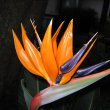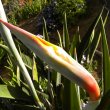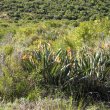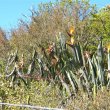| Botanical Name |
|
| Family |
Strelitziaceae - The strelitzia family. |
| Pronunciation |
stre-LITZ-ee-uh ree-JIN-ay-ee |
| Common Name(s) |
English: Crane flower; Bird of Paradise Flower
Afrikaans: Kraanvoëlblom; Geel Piesang
|
| Plant Group |
- Bulb / Corm / Rhizome / Tuber / Epigeal bulb Bulbs: are made up of fleshy scales as in an onion
Corm: a short, swollen, underground stem that is hard and not fleshy as in a gladiolus
Tuber: a solid, fleshy, underground, storage organ as in a potato
Rhizome: an underground, horizontal, swollen stem at the base of the plant as in an iris
Epigeal bulb: bulbs that rest above the ground with only the roots anchoring the plant to the earth as in albuca
|
| Plant Size |
- Very large
| Tree | Over 25m |
| Shrub | Over 4m |
| Perennial/ground cover | Over 1m |
| Bulb | Over 1.2m |
| Succulent | 1.5m to 2m |
|
| Position |
- Canopy Shade Canopy shade is found below closely grown trees where some light filters through. Ideal for the protection of herbaceous plants.
- Deep / Full Shade Shade below spreading evergreen trees where sun's rays are unable to penetrate the canopy at any time. For light sensitive plants
- Dry Shade Shady areas where soil has poor water retention or are dependent on rain for their moisture needs.
- Light or Dappled Shade Found below trees with sparse, open foliage. Ideal for the protection of herbaceous plants.
- Partial Shade The area is in shade for part of the day and in full sun for part of the day.
- Sun The area is in full sun for all or most of the day, all year round.
|
| General Information |
- Attractive fruits, berries or seeds Brightly coloured fruits or berries increase and extend the visual impact of the plant and are especially attractive to birds and other small wildlife.
- Drought Tolerance: High The plant is well adapted to arid conditions; it can survive long periods of drought and high temperatures without extra water.
- Evergreen Plants that have leaves all year round.
- Frost: Half-hardy The plant is able to survive low temperatures and some frost but requires protection against severe frost.
- Roots Invasive Do not plant near pools, paving, walls or buildings.
- Water Wise Plant species originating from low rainfall regions that require less water to survive and thrive than other plant species.
- Wind Tolerant Plants able to withstand the effect of strong winds.
|
| Specific Information |
The tough, grey-green leaves of Strelitzia reginae grow about 1,5 m tall with the flower heads reaching above the foliage. The stiff leaves grow up from the base of the plant and form large clumps. Strelitzias resent being moved and if disturbed they may sulk for a year or two before showing signs of growth. This is perhaps one of those plants best obtained from a reliable grower. The plants on offer should be tight in their bags, have a strong, full root system, visible, healthy, young growth and an absence of dead or dying leaves.
|
| Ad Break |
|
| Flowers |
| Description |
striking head with long petals, reminiscent of a crane's crest
|
| Season |
- Autumn to Spring Plants will seldom bloom for the entire season as given in the list, but should flower during a period within these parameters.
|
| Colour |
|
| Growth Rate |
- Moderate Specifying growth rate can be very misleading as there is considerable variation of growth rate depending on type and species of plant, available water, supplementary feeding, mulching and general care, as well as the plants suitability and adaptability to the garden environment.
|
| Plant Uses |
- Accent or Focal Point A plant used to attract the attention because of its colour or form.
- Attracts bees, butterflies or other insects This plant attracts insects which can be food for birds or other creatures in your garden.
- Attracts Birds This plant will attract birds.
- Border A strip of ground, at the edge of a driveway or path in which ornamental plants or shrubs are planted.
- Boundary A plant useful for planting around the edges of the property to form a green or colourful backdrop, an impenetrable hedge, to hide walls or create privacy.
- Container Trees, shrubs and ornamental species that can adapt to growing in a restricted environment.
- Cut Flowers Plants that provide flowers suitable for ornamental uses.
- Filler Either a fast growing tree or shrub used temporarily to fill in an area while the permanent plants grow to a desired size, or a plant used to fill gaps in borders or beds.
- Mass Planting Plants useful for filling a large area with just one or a few kinds of plants spaced close together. Creates a bold, dramatic effect and to reduces maintenance.
- Rock Garden An area constructed of larger rocks, arranged naturally, to emphasise the use of stones as a main element. Generally plants used do not need a lot of care.
- Screen A tall hedge of suitable plants planted closely together and used as a windbreak, to block a bad view, to separate parts of the garden or as a backdrop.
- Stabilize Banks Plant is used to prevent soil erosion because their roots will form a mat that stabilizes the soil and keeps it from washing away in heavy rains.
- Suitable for coastal gardens Plants adapted to dry, sandy soil, forceful wind, limited rainfall and intense sunlight.
- Water Features These plants may have dramatic, lush foliage or graceful form. They do not shed excessive leaves and do not have invasive root systems.
- Wild Garden An indigenous garden planted for the benefit of wildlife and birds. Provides food, water, a variety of mini-biomes and no poisonous chemicals are used.
|
| Distribution and Habitat |
Eastern Cape and KwaZulu-Natal, along riverbanks and clearings in the coastal bush
|
| Planting Suggestions |
For best results, grow Strelitzias in a rich loamy soil with plenty of water, fertilizer and compost throughout the year. Once established Strelitzias will thrive in most soils with very little water. Strelitzias are sensitive to cold and frost and must be placed in a sheltered position. In very cold climates grow Strelitzias in pots that can be moved to shelter when frosty temperatures are expected.
|
| Medicinal Uses |
|
| Ad Break |
|










Comments
strelitzia reginae
after it has flowerd were shoud the stem be cut off , below the flower or at the bottom of the stem
Dead-heading Strelitzia
Hi Johan
I cut my heads off as far down as I can reach at the base of the stem. I have found that removing dead flowers as soon as possible extends the flowering period appreciably and keeps the plant looking neat and elegant. I also remove dead, ragged, diseased or dying leaves regularly.
Kind regards
Lorraine
Strelitzia poisonous?
My cat has chewed on the tips of the new leaves of my potted plant which I had to bring in because of cold weather. I did not realize she was doing this however ( just thought the new leaves were deformed). She has developed liver disease recently. Tonight I found a chewed up piece of leaf on the floor by her dish. Could S. Regina be responsible for her health problems? Have tests been done on the chemical properties? Thank you for any information you can share with me.
Toxicity of Strelitzia leaves
Hi Judy
I have had a number of queries as to the toxicity of Strelitzia leaves to humans as well as to cats and dogs, but there seems to be very little documented information available.
The only information I have found is from a couple of overseas sites which list all the Strelitzia family as poisonous to dogs. However there is no such indication in any lists of poisonous plants in South Africa - even from Pretoria University, which includes the Vetinary college at Onderstepoort.
In my opinion, if the plant were in any way poisonous, it would have been well documented.
Perhaps another visitor to the website will be able to enlighten us in this regard.
Kind regards
Lorraine
Discuss this plant
Share knowledge, ask a question or give an experience.